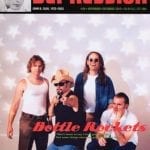Handsome Family – Tragic songs of life
On an early September evening, across the U.S.A., a million little girls — and quite a few boys, too — gasp suddenly, struck by a fleeting spasm of pain. The origin of this mysterious discomfort? Rennie Sparks of the Handsome Family, who has just expressed a sentiment so profane, it reverberates across the psychic network of children nationwide.
Rennie Sparks hates The Little Mermaid.
Rennie and her husband, Brett, are finishing dinner at an unassuming southwestern chow palace in Albuquerque, New Mexico. Conversation turns to the misconception, fostered by some reviews — the ones that liken the Sparkses to the Addams Family rather than the Carter Family — that the duo’s songs are depressing, creepy, or even harmful to mental health. “It’s a weird attitude that people have lately, that sadness or anything dark could actually hurt you,” observes Rennie. “Like an unhappy ending could make you so unhappy you might die.”
“If The Little Mermaid had the original ending…” begins Brett.
“Don’t get me started on The Little Mermaid,” snaps Rennie. But it’s too late. In Hans Christian Andersen’s 1836 fairy tale, she notes, the sea princess suffers grievously. She surrenders both her tongue and her tail to pursue a landlubber who not only tosses her over for another, but, in doing so, dooms the mermaid to dissolve into sea foam. (Well, unless she fatally stabs him and bathes in his blood, as her sisters beg her to do. No dice.) Not so in the 1989 animated musical. In that version, pretty Ariel and the Prince get married, and raise a litter of sea monkeys.
“The impulse of Disney is to take that sad ending away from kids, so they don’t experience any pain,” Rennie laments. “But that [original] story makes you realize that even though you are mortal, you can have this great love, and make a meaningful connection to the world, even if the world doesn’t love you back. That’s an important message. Whereas now they’re saying that, unless you marry a prince, that’s it. And that’s really hollow, because there is no happily-ever-after. Eventually, you have to deal with the fact that both you and the Prince are going to die.”
In Handsome Family songs, people die. When their debut album, Odessa, appeared on Chicago’s Carrot Top Records (home of all their studio full-lengths) in early 1995 — a year before Nick Cave’s Murder Ballads hit college radio — some stations raised a stink about “Arlene”, in which a woman is bludgeoned to death. On their latest, Singing Bones, the body count includes a battlefield littered with corpses (“Fallen Peaches”) and a prospector who perishes in the desert, listening to “The Song Of A Hundred Toads”.
Rennie and Brett Sparks have been making music as the Handsome Family for nearly a decade. She writes the lyrics, he composes and records the music. Brett renders Rennie’s words in a restrained, even baritone that throws her often startling images and narratives into even sharper relief. They both play an assortment of instruments: guitar, banjo, autoharp, melodica. Over the course of six albums, they have won praise on both sides of the Atlantic (the British market has been particularly receptive) for their intimate artistry.
The Handsome Family know how to spin a captivating yarn. No “happily ever after” required.
These days, the Sparkses live and work in a modest, two-bedroom pueblo-style house built in 1938. It sits a few blocks off Albuquerque’s main drag, Central Avenue, better known as historic Route 66. The decor features a giant tapestry of deer frolicking in a forest (purchased at a roadside flea market in Scandinavia), a cow skull and a horse jaw, and a pair of Van Gogh-like paintings by Rennie’s grandfather. Two cats, Foot Foot and Mr. Pink, scamper across a coffee table Rennie fashioned from an old door.
The backyard, once barren, has started to shape up nicely. Cacti are especially plentiful. “I need plants I can forget about,” demurs Rennie. Bluejays fly up to the house to eat the peanuts she offers. Big nature lovers, the Sparkses. Beasts and birds figure prominently in the Handsome Family’s album art and Rennie’s lyrics. In the kitchen, an extensive collection of dog food cans, each bearing the face of a happy pooch, beams down from atop the cupboards. They are contemplating a move outside of Albuquerque proper, to nearby Cedar Crest, a more rural setting, complete with coyotes, mountain lions, and bears. (Oh my.)
Singing Bones is the Handsome Family’s first proper album since they left Chicago two years ago. (In the interim, they released a concert disc, Live At Schuba’s Tavern, and a rarities set, Smothered And Covered.) “We’d always thought about moving back here, but we figured it would be career suicide, because of the lack of hipsters,” cracks Brett, who had lived in New Mexico previously. It wasn’t. In fact, the change of address helped breathe new life into the making of their sixth studio full-length.
“There’s not as many songs about snow,” laughs Rennie, when pressed to describe how the move shaped her words. “I spent twelve years in Chicago, shivering.” Gold, light, sunsets and the mountains — all key features of the southwestern landscape — pop up frequently in her language on the thirteen new selections. “When I was in Chicago, I was really obsessed with the forest, because that seemed like the antidote for were I was,” she adds. “Now I find that I’m thinking about the ocean a lot. The desert reminds me a lot of the ocean, when you look across it. That’s probably why I put the sea on the cover.”
For Brett, who grew up in Texas, New Mexico, and Nevada (his father was an oilman), the decision to integrate hints of regional culture into the music was more calculated. “Far From Any Road” is peppered with mariachi brass, and “Gail With The Golden Hair” invites comparisons to the standard “South Of The Border”. “I very consciously wrote two songs on this record that were overtly southwestern,” he admits, “probably just because I felt it was expected of me to do so.”
But coming out west effected the genesis of Singing Bones in less obvious ways, too. For the first time, they were able to set up a proper home studio — it doubles as the laundry room — which afforded Brett sonic opportunities the Sparks’ Chicago loft never did.
“I was always finishing these goddamn records in summer, trying to do guitar overdubs,” he remembers. “It would be so hot out, and you’d put a condenser mike up to the guitar…and then a bus would go by outside.” Consequently, he ended up recording a lot of parts directly into the computer. “Now I have this really controlled, hermetically sealed environment, so I could record really small sounds, like claves and castanets, or saw.”
He also taught himself to play pedal steel for Singing Bones. “The hardest instrument I’ve ever played,” he remarks twice in one evening.




